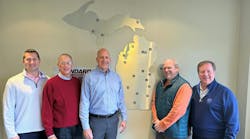A recent forum on mergers and acquisitions that EW co-sponsored offered some fascinating insights into where the acquisition game may be headed in the future.
Attendees at the "Electrical Distribution Industry M&A Forum," co-sponsored by Electrical Wholesaling magazine, Fulcrum Information Services, New York, N.Y., and several other companies, came away from the two-day seminar with much more than Fulcrum's inch-thick notebook of speakers' overheads, speaker biographies, company profiles and PowerPoint presentations.
An all-star panel, which included some of the biggest players in the electrical wholesaling industry's acquisition game, gave a two-day primer on all the basics of selling or buying an electrical distributorship. But the panel, which included Anicom's Scott Anixter, GE Supply's Scott Telesz, Graybar's Beatty D'Alessandro, Sonepar's Richard Worthy, WESCO's Roy Haley, and industry consultants such as Adam Fein, Neil Gillespie and Michael Marks, delved deep into the roots of the consolidation now reshaping the electrical wholesaling industry.
No single factor is responsible for the flurry of acquisitions in the past few years, the forum's panelists concurred. They said easy availability of funds for acquisition sprees, the "graying" of the electrical wholesaling industry, foreign players looking to expand in the U.S. market, potential competition from Internet-based competitors, customer consolidation, national-account contracts, broad distribution industry trends and the necessary massive information technology (IT) investments by distributors all contribute to a super-heated merger and acquisition environment.
However, all of the panelist emphasized that with any family-owned business, the decision to sell the company is a very personal one, and that any prospective seller has a unique set of reasons for making this decision. However, it does seem like more companies areat this crossroads than ever before.
"We have a very hot market," said Michael Marks, Indian River Capital Partners, Melbourne, Fla., an industry consultant who has studied the consolidation trend across a broad range of distribution-based industries. "There is more money than there are people to buy."
The information-technology (IT) investment that electrical distributors of any size must make to compete in the future has prompted more than one small-business owner to cash out and sell his company. Adam Fein, president, Pembroke Consulting, Inc., Philadelphia, said smaller companies often must decide whether to rip out older computer systems and install expensive new hardware/software packages to help manage their businesses, or not invest in information technology and instead polish up their balance sheets to make their companies more attractive to buyers.
Several of the forum's panelists agreed that the IT investment decisions will become more important than ever, as electrical distributors must decide if they want to commit to new tools of electronic commerce such as the Industry Data Warehouse (IDW) and online storefronts. A factor that drives up the cost of these investments is when electrical distributors are a few releases behind on their business software, and they have to invest more in their software to catch up to the releases that can handle these new technologies.
These new information-technology systems will allow distributors to open online storefronts and streamline the entire ordering process for customers, said Neil Gillespie, president, Infinity Strategic Consulting, Pittsburgh. He gave the example of the time that an electrical distributor's inside salespeople now need to translate a customer request for information on product pricing or technical specifications. Gillespie estimates that distributors' inside salespeople now spend 60% of their time translating "loosely specified ordering information," into real orders. But if customers could enter the same information on an electrical distributor's Web site, Gillespie said inside salespeople would not have to do this translation and could spend their time more productively. He sees a time when an electrical distributor's inside sales team could spend more of their time proactively selling to their own group of targeted accounts that might not require visits from field salespeople, or providing field salespeople with additional product, technical or application expertise, instead of having to focus on routine order-entry tasks.
Ken Fairleigh, vice president of sales and marketing for Square D Co., Palatine, Ill., agreed that electrical distributors will have to make the necessary information-technology investments to upgrade their computer systems. However, he added that in the future, electrical distributors may not have much choice because their key vendors and customers will demand it of them to ensure a smooth flow of electronic information that will slash procurement and order-fulfillment costs.
Several of the forum's panelists agreed that the biggest potential powderkeg that electrical distributors and manufacturers will have to deal with regarding the Internet is the issue of distributors selling online across traditional territorial boundaries and how this practice will affect the Areas of Primary Responsibility (APR), particularly for electrical manufacturers with highly selective distribution networks, such as Rockwell Automation/Allen-Bradley. Sonepar's Richard Worthy told the forum's audience that if "the APR ever goes away for Allen-Bradley, it's a whole new ballgame."
Michael Marks of Indian River Capital Partners expects the electrical wholesaling industry to consolidate faster in the future, but believes APRs are "the biggest impediment holding up this consolidation."
Another key issue facing smaller electrical distributors is the desire of customers to deal with larger entities. This desire has surfaced in the electrical business in several different forms, including the national-account contracts that larger firms sometimes now desire for commercial-maintenance or industrial MRO products, and the move by Wall Street to back contractor consolidators, both of which are changing long-term relationships that electrical distributors have with customers.
John Pollock, vice chairman, Integrated Electrical Services Inc. (IES), Houston, has spent a lot of time over the past two years talking with distributors and manufacturers about IES's purchasing policies. He says that while the company is exploring many options, including sourcing some products through national distributors, local distributors will still play an important role. He said distributors must understand that while contractors are always going to be concerned with the prices of the products that they purchase, they have bigger concerns.
"Our big risk is not the cost of the material," said Pollock. "It's the labor. If the cheapest products cost more for us to install, all of a sudden it's not the cheapest product."
While much of the forum's discussions covered these trends, the evaluation of distributor financials and the development of realistic multiples for purchase prices, the audience also got an inside look at the M&A experiences of the legendary Anixter family.
Through its involvement with Englewood Electrical Supply Co. (EESCO) Inc., Anixter, Inc., and most recently Anicom, Inc., the family has probably bought and sold more companies than any other in the electrical wholesaling industry. Scott Anixter, chairman and CEO, Anicom, Inc., Rosemont, Ill., said that his family had bought about 60 companies and sold about 20 businesses, but that because of the difficulties in blending companies together, "It's about one-in-10 that you buy a company and everything runs smoothly."
* The "graying" of the electrical business. Because so many electrical supply houses were founded in the early post-World War II years, many company owners are at or near retirement age -a time when many of them decide to sell their companies.
* Inadequate succession plans. All too many electrical distributors never commit to a formal succession-planning process. When it's time to make these important decisions, they have to scramble. It's a tough process and a very personal decision to go through for any company because of family pressures, but it's even worse when the planning process begins too late.
* More companies looking to grow their existing businesses. As existing distributorships strive to achieve critical mass to compete with larger competitors, acquisition is a popular growth strategy.
* Foreign-based distributors like Hagemeyer, Rexel, Sonepar and Westburne building businesses in the U.S. market. These foreign companies see the U.S. electrical wholesaling industry as a high-growth market compared to the business in most other areas of the world.
* Easy access to investment capital. As long as commercial credit from lenders is widely available to acquirers, the cash will be there to fuel mergers and acquisitions of electrical distributors.
* Major investments necessary in Information Technology (IT). As more business is conducted electronically and the computer system becomes a more important element of the central nervous system of any electrical distributorship, companies will have to invest more to keep them up to speed.







